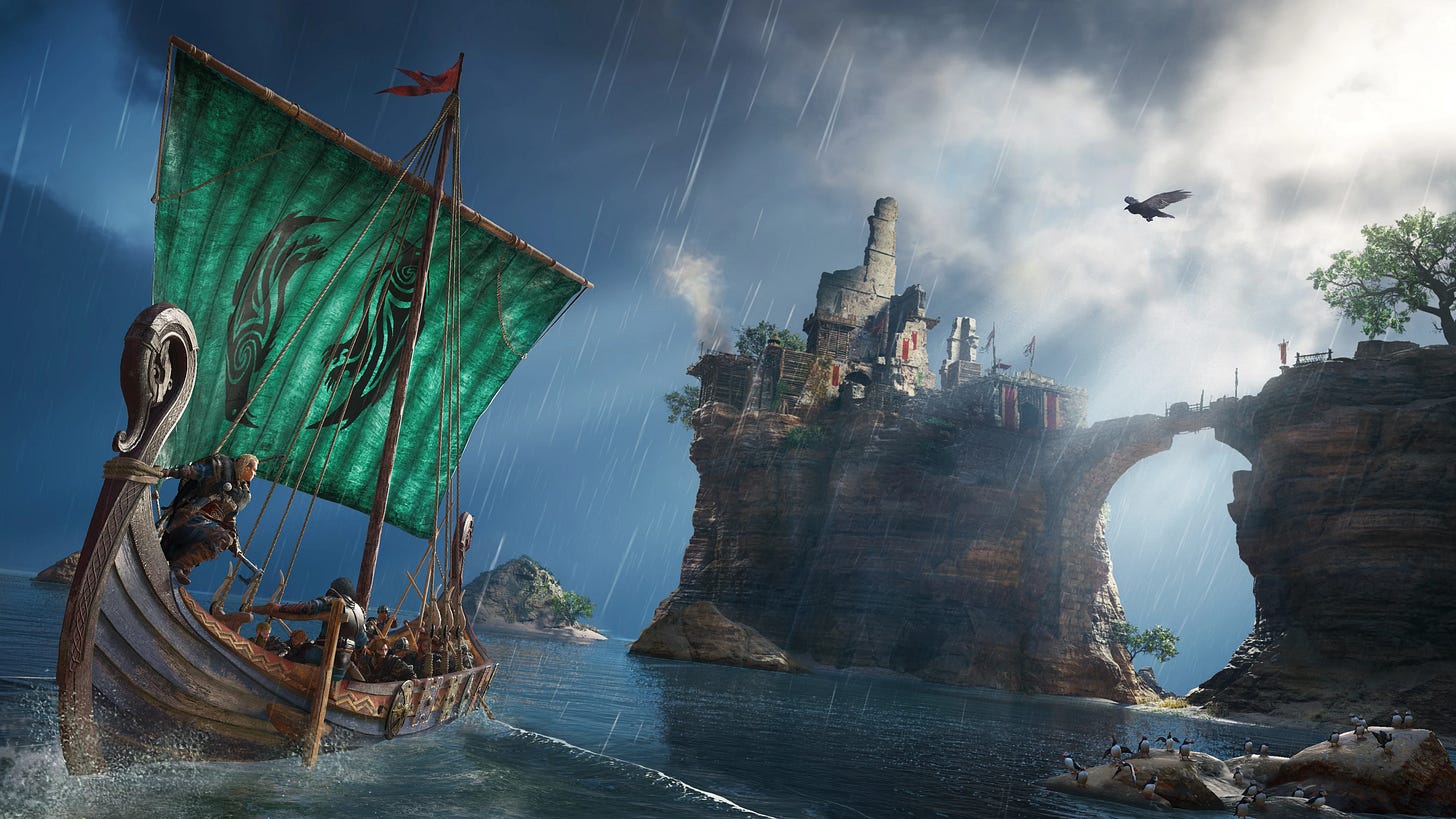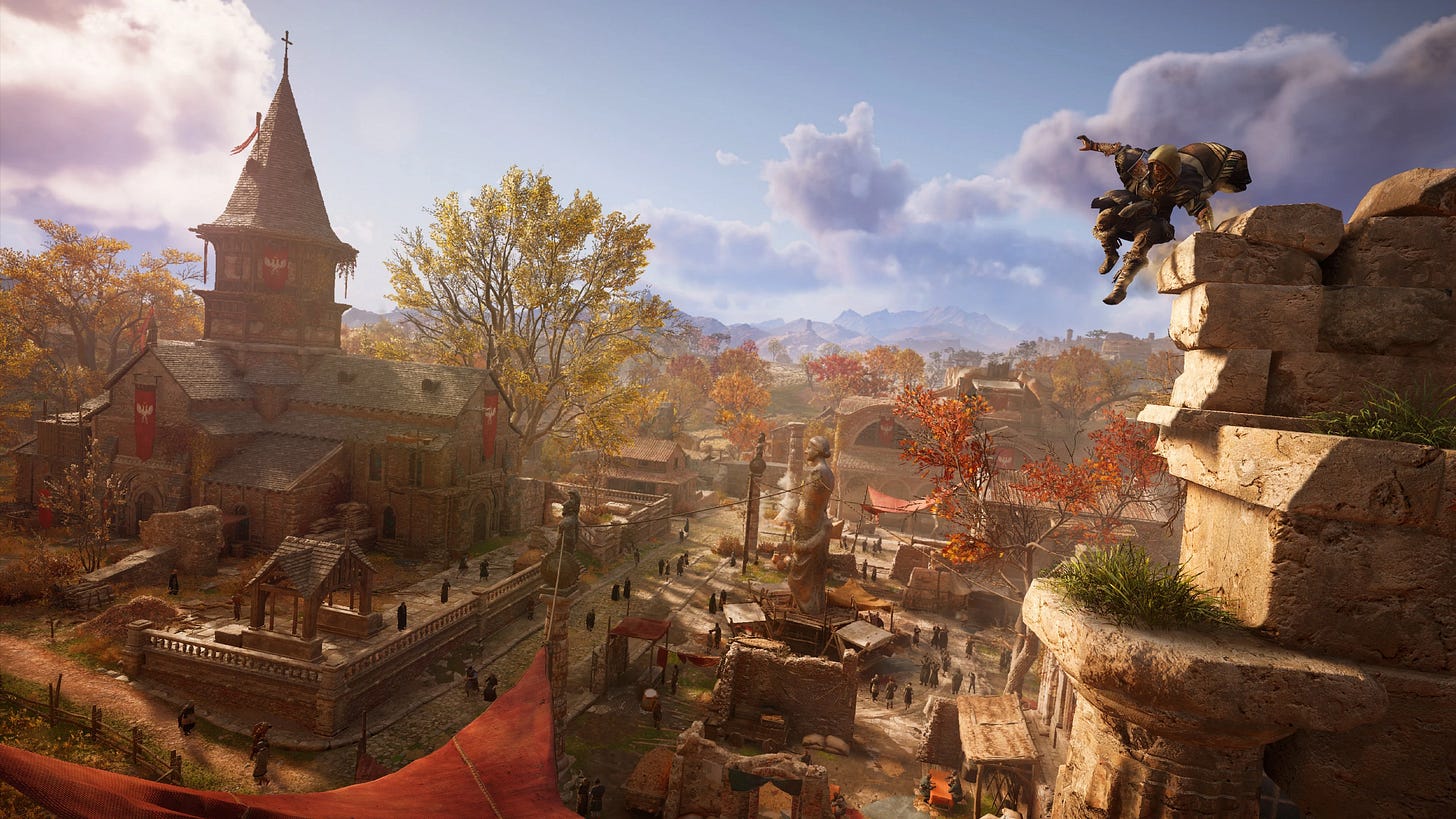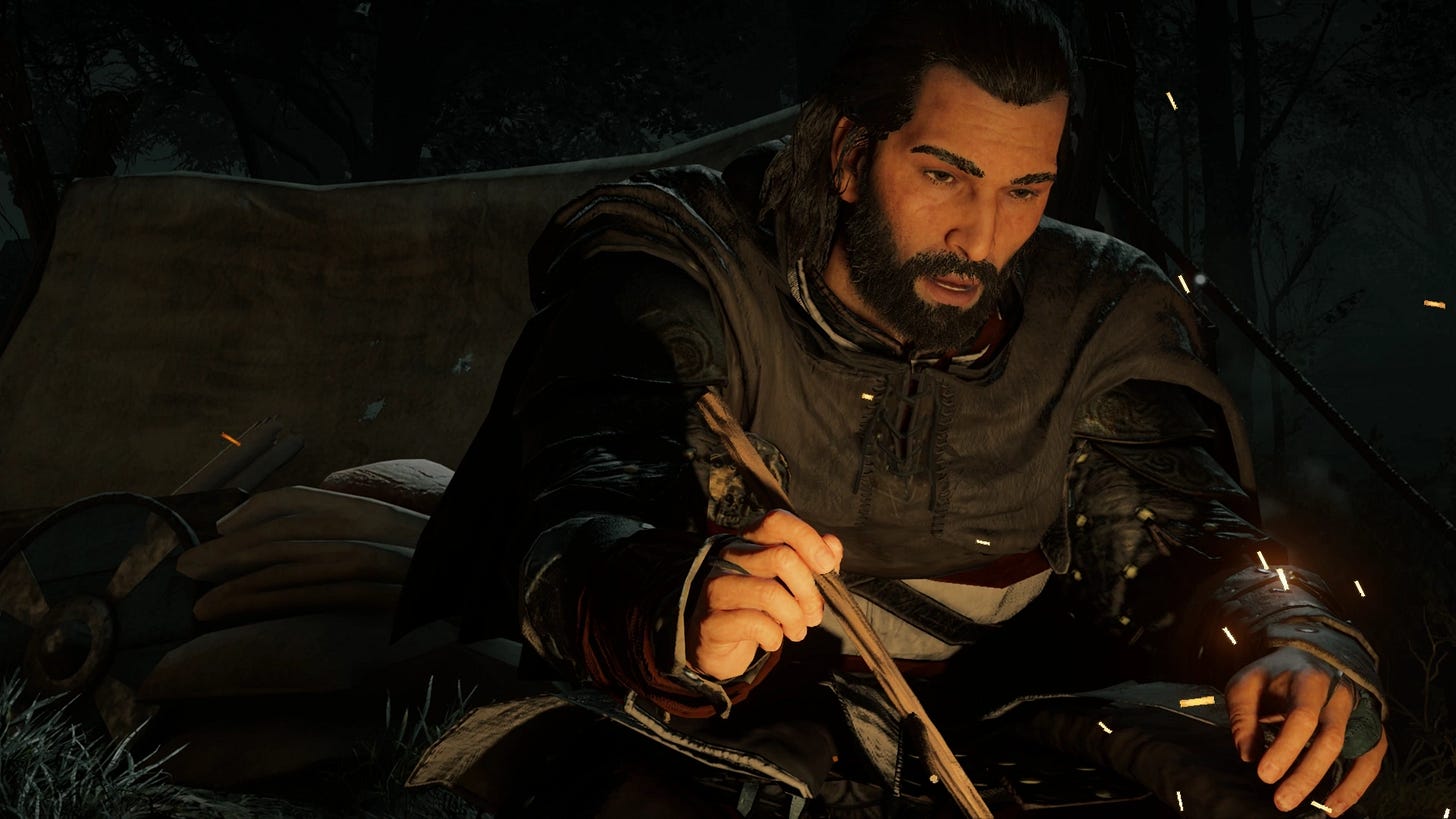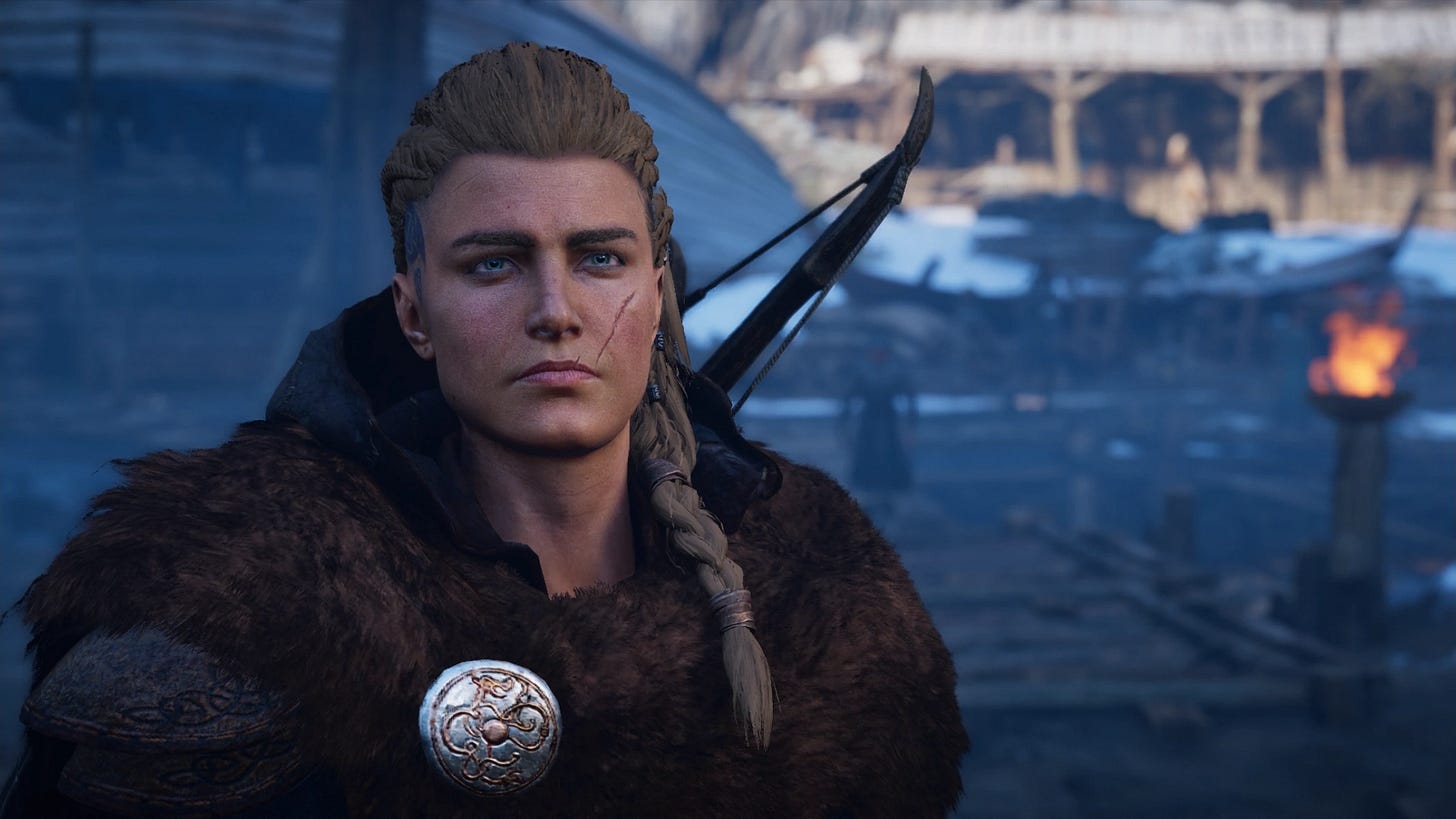Assassin's Creed Valhalla: An Off-Balance Retrospective.
The road to glory is paved in blood.
Table of Contents
Even as it quickly established itself as one of the biggest names in gaming, Ubisoft’s Assassin’s Creed franchise was never one to shy away from its idiosyncrasies.
Long-ago artifacts of great power, globetrotting secret societies or an undeniably unique mix of historical and science fiction which had no true medium equal.
Though on the same hand, in finding that creative groove, particularly as it followed a yearly release schedule, familiarity became another calling card. The response then, with 2017’s Origins, was to see then series close out its first decade with a revamped approach.1
From the shift towards RPG-based mechanics with its combat and exploration or the overall crux of the storytelling. A prequel, taking place centuries before any previous title, while looking to show the, well, origins of the Assassins and Templars both. 2018’s Odyssey further expanded on this, though in its own way, with a vastly more self-contained approach in comparison to even its direct predecessor.
But with Assassin’s Creed Valhalla, lead developer Ubisoft Montréal looked to bring all those elements, past and present, together once more.
The more explosive combat of the prequel era, paired with the stealth-driven tactics of the earlier games. An open world of massive scale. A deep respect for the franchise’s extensive lore, interwoven with a mostly standalone viking epic, spotlighting a highly transformative historical period.
Easily the biggest, most ambitious title in the series, Valhalla turns five this month, having first released in November of 2020.
And today at Off-Balance, we’re taking a look back.
To the swan road we go.
Intro (Valhalla)
In mid-ninth century Norway, after her parents are killed and village razed, young Eivor Varinsdottir (Cecilie Stenspil) is taken in by the Raven Clan, vikings, who embrace her as one of their own.
And though she is often troubled by her childhood loss and recurring visions of the Norse god Odin (Magnus Bruun), in adulthood, Eivor has become a skilled warrior in her own right, a raider, of some local renown.
Yet when her adopted brother Sigurd (Gudmundur Thorvaldsson) returns from an extended voyage abroad, he brings with him more than just stolen riches.
As in tow are Hytham (Amir Sám Nakhjavani) and Basim (Carlo Rota), members of a mysterious organization known as The Hidden Ones. Who, while introducing Eivor to their teachings also warn her of their mortal enemies, The Order of the Ancients.
Though when the power of the individual Norse kingdoms is consolidated, the Raven Clan, led by Sigurd, Eivor and Sigurd’s wife Randvi (Kajsa Mohammar) relocate to the English Midlands to begin anew. Drawing the attention of not just the country’s already entrenched viking armies (and the gathered Ancients) but Alfred of Wessex (Tom Lewis) as well - he, with motives that will affect more than just the Isle.
Eivor’s true purpose in England however, is far grander than plain conquest.
Her destiny, stretching across time, oceans and Norse mythology itself as she unearths ancient secrets thought long buried in the process.
So as the story unfolds, Valhalla’s combat and stealth mechanics aren’t far behind: building on the foundation of their predecessors while standing somewhat apart too.
Combat + Stealth

Three games into the series’ RPG-era, Valhalla’s combat/stealth blueprint feels, if not wholly perfected, then at large, further developed.
The dodge-parry system, focusing on movement and arena control returns and while abilities, specialized combat moves, are still mapped with a trigger/face-button combo, without Odyssey’s Piece of Eden-driven power fantasy, they are comparatively more grounded, considering (axe throwing, body slams, one-on-one takedowns, etc).
Adrenaline then, by default, is in short supply, meaning alongside Valhalla’s addition of a stamina bar, Eivor isn’t a bulldozer right from the jump.
Dodging, heavy attacks, light attacks that miss their mark, all these deplete the bar. Not completely changing the flow of combat but adding another element to consider, more so early on, when one is still at the mercy of the larger system, where being overwhelmed can and will happen quickly.
The hack-and-slash base is still present and noticeably, feels far rougher, technically, than it did in Odyssey but Valhalla’s enemy variety, with tougher foes (Goliaths, pikeman, shield-bearers) do require a touch more strategy then its predecessor, particularly on higher difficulties: working to expose their flank, using the bow-and-arrow to quickly disable an opponent or targeting highlighted weak points. Depleting an enemy’s stamina bar will open them up for a “stun”, a vicious finishing move that will see Eivor take them down with a pronounced flourish, be it beheadings, severing limbs or turning their own weapon against them.
Alongside the roaming and set mini-bosses like Zealots, legendary animals and the Daughters of Lerion which can be found throughout England, Valhalla consistently works to provide new ways to engage with its combat, throughout its many hours - through an enemy’s resistance to certain attacks or sporting individual attack patterns which must be learned in order to successfully defeat them.
To this, the player has a variety of weapons, gear, abilities and skills at their disposal. Gear and weapons come in three distinct classes (Raven, Wolf, Bear) that broadly cater towards a specific approach but in an effort to lessen inventory management, each item is unique and can be, should the player choose, sequentially upgraded (both statistically and visually, alongside a transmog system).
Axes, shields, flails, spears, broadswords and war hammers, all can be used in whatever combination one chooses (one weapon in the primary hand, one in the off-hand), adding a fun wrinkle to every encounter, be it a one-on-one showdown or crowd control. Experimentation is encouraged then, as the player must find the loadout and active skills/abilities that best suit their play style, be it combat-heavy, ranged, a healthy mix of both, etc.
Now, the game’s numerous DLC expansions do add additional weapon types (sickles, scythes, atgeirs and one-handed swords), power-sets and new ways of approach, with The Forgotten Saga, for example, being a combat-based rogue-like.
Their inclusion however, for most, will come near the end of any given play through and ultimately, while they add some noted variety, won’t move the needle all that much.
Conversely, there are Valhalla’s Pieces of Eden, which put an expected, AC style spin on weapons of Norse, English and Irish mythology. But while they may share animation packages with their base counterparts, unique passive buffs, ranging from an area-of-effect attacks to stun bonuses help to keep them distinct (the difference, for example, between a run-of-the-mill war hammer and a long-recovered Mjölnir? It is apparent and fittingly, striking).
Bows however, similar to Origins, are divided into three categories, light, hunter and predator.
Each can be utilized for either stealth or quick-fire combat scenarios and paired with the proper enchantment runes, for additional speed and damage, they can provide a boost to those encounters. Though unlike Origins, in which two different bows could be equipped simultaneously, in practice, needing to pause, navigate to the inventory page, deselect and then select one’s bow of choice, it simply isn’t worth the trouble. Deciding on one and upgrading it as needed is the far easier play.
And while not all of Valhalla’s combat elements are seamless - the bloated skill tree or the lack of polish that defines raids and sieges, most prominently - what promotes its memorability is the feeling it shoots for, that of an viking, an unstoppable war machine, tearing through any that oppose them.
It is, though, only one side of the coin.
Stealth, being the other.
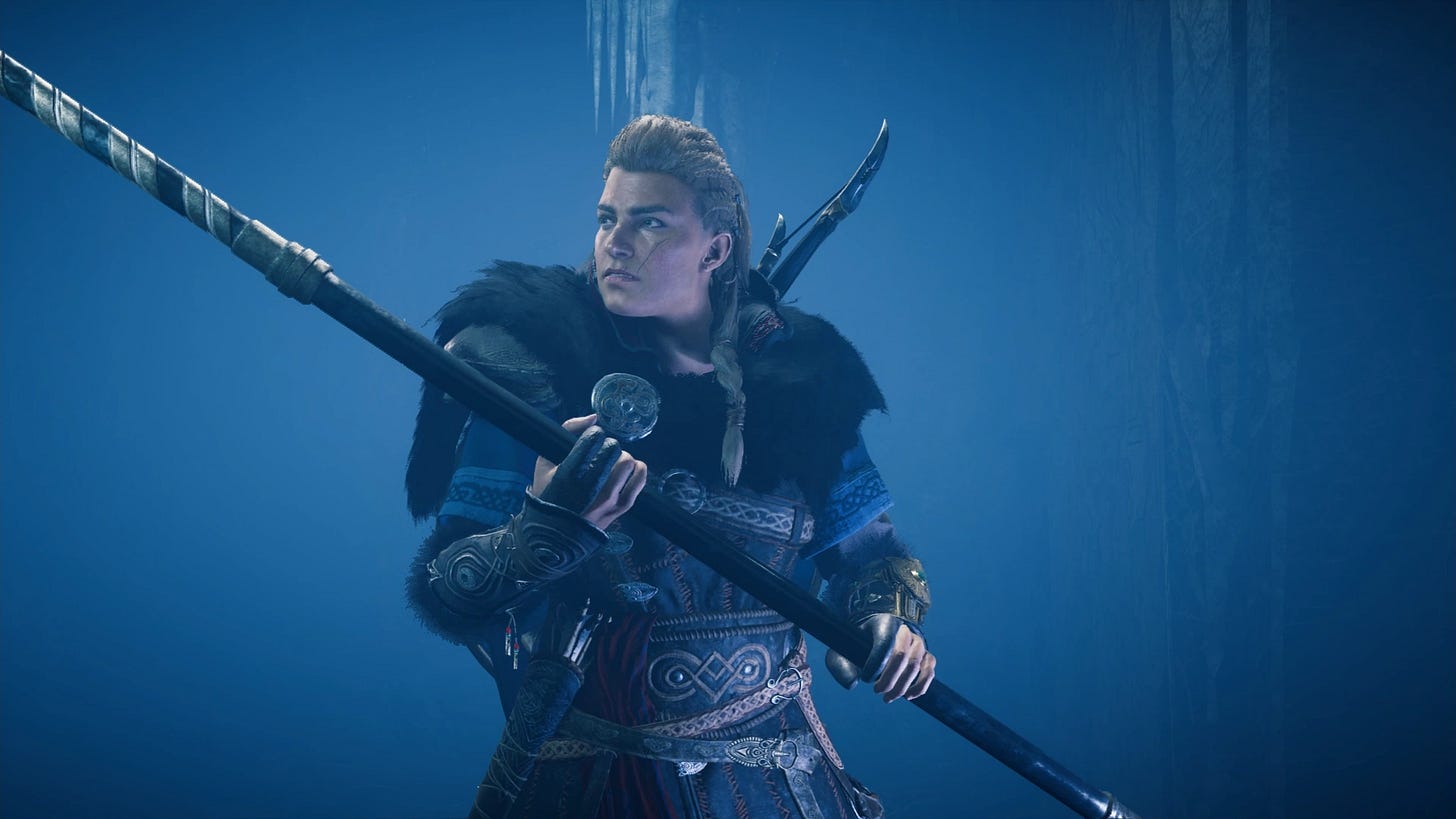
Right from its opening hour, Valhalla is clearly eager to highlight its melding of Assassin’s Creed past and present, especially as it relates to the game’s stealth mechanics.
Gifted a Hidden Blade by Basim, Eivor quickly takes to the weapon, even if she chooses to wield it, unconventionally, on the outside of her bracer (itself a nice character touch, as unlike the Hidden Ones, she has no wish to hide it from her enemies).
After a one-game absence in Odyssey, the Blade makes its return here, even if its execution has been tweaked.
By default, attempting to assassinate higher-levelled enemies will trigger a success-or-fail QTE, which, mistimed, will force the player into open combat. It does add something of a risk-reward approach to each encounter, more so in the early hours and if one wishes, they can turn it off entirely (in then returning to the classic, insta-kill style).
Practically speaking, though Eivor’s assassination animations, heavy and deliberate, lack the fluidly of prior protagonists, further tutored by Basim and Hytham both, she does become skilled in moving through the world as a Hidden One would. Be it learning the Leap of Faith or utilizing social stealth, which makes its return to the series for the first time since 2015’s Syndicate.
And although it was played up in the marketing, it is not as all encompassing as it was in previous titles, recalling, at its best, the mechanical inclination of the original Assassin’s Creed: Eivor, only able to blend with specific groups via a designated button prompt and through this, being locked into action-based activities (all the series fundamentals are still there though, to be fair, be it whistling from a bench/haystack or taking down a target from a ledge). Throughout England, the player will often find themselves in restricted areas which are openly hostile to vikings, forcing them to pull up Eivor’s hood and step with care.
Both versions of another franchise staple, Eagle Vision, return as well. The physical mapping of an environment (here dubbed “Odin’s Sight”) helps to pinpoint useful items, enemies and collectibles, while the avian familiar, Eivor’s raven Sýnin, can be used to scout ahead and grant a birds-eyes view of one’s surroundings, when possible, prior to any infiltration.
The delivery of both has been tweaked of course, which tracks, if not to tilt the scales too far in the player’s advantage. Odin’s Sight, being more of a burst then continued pressure while Sýnin, unlike in Origins and Odyssey, cannot tag or hone in on mission objectives in the same way. Limited no doubt, in an effort to curtail an over-reliance on a bevy of supports.
The catch though, overall, is that Valhalla’s stealth expands only marginally within the confines of the base game, smaller wrinkles, at best. Sure, it isn’t as though the earlier games in the series had anything deeper to offer but, on the whole, they never pushed past the thirty-forty hour mark as their baseline, either.
No, it isn’t poorly implemented per se but it does feel, at times, like something of a half-measure. Wanting to hit that unique quota (of being a viking-assassin), without ever totally committing to stealth in the same way it does combat.
It does line up, it should be said, from a story/character point-of-view.
While Eivor comes to develop a great respect for the Hidden Ones, she never actually joins the Brotherhood and therefore isn’t fully immersed in their way of operating. Though as the Siege of Paris DLC would show, specifically with the return of the franchise’s much-loved “Black Box” missions, there was more to present here, while still staying true to her character (and while Dawn of Ragnarök leans back into the series’ sci-fi roots with its combat-stealth additions, they are siloed within that space and not accessible elsewhere).
It is engaging with the world, either way however, on which Valhalla choses to place a good amount of its energy, be it in Norway, England or worlds far beyond their borders.
Open World + Exploration
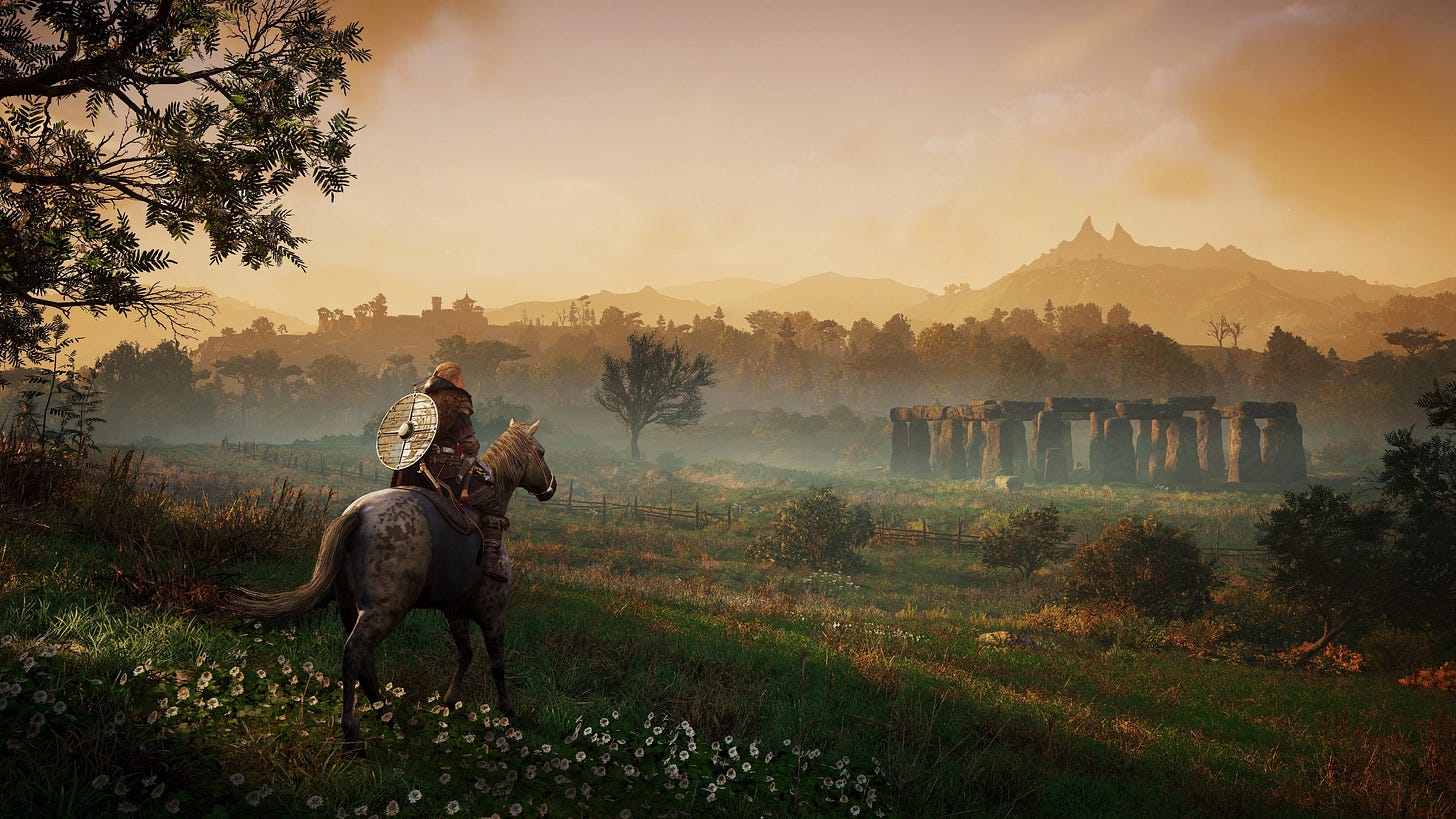
To consider AC’s open worlds, it is to see a steady evolution.
III, Black Flag and Rogue in particular moved beyond the established, city-based loop, adding larger, more free-form areas, be it swathes of Colonial America, a pirate-dominated Caribbean Sea or the isolated Canadian Arctic.
Origins expanded on this template even further, in bringing an entire portion of a country, Ptolemaic Egypt, to life and Odyssey, not to be outdone, did the same with Ancient Greece.
Valhalla then, in this respect, isn’t surprising whatsoever.
Nearly bursting at the seams as, in the base game alone, it depicts Norway, Saxon-Norse England, a Norse colony in North America (an embellished account of Vinland), in addition to the realms of Asgard and Jotunheim. It is a sense of pure expansion that is further seen in the game’s numerous DLC episodes, as well. A Christian-Druid Ireland and a slice of the French countryside anchored by Paris, Scotland’s Isle of Skye or further adventures into Norse myth (primarily, Svartalfheim and Niflheim).
And so, to the larger team’s credit and as expected from a Ubisoft title, every region is rendered at a high level, from the geography, lighting and colour palettes, to the distinct style for each that is present throughout.
Be it Norway, its snow-capped mountains paired with the splendour of the Northern Lights or the sheer variety present in England, for which the player will spend the vast majority of their time. York (Jorvik), further north, with its dense streets and Yuletide cheer masking corruption or London, a budding (relative) metropolis, struggling to find its own identity amid the towering remnants of the Roman Empire.2
A nigh-forgotten hamlet, not completely untouched from war but providing something akin to quiet sanctuary. Trying vainly to steady one’s longship against the White Cliffs of Dover or traversing the moors and marshlands of East Anglia. The wind-battered longhouses of Hemthorpe or the Christian stronghold of Alfred’s Winchester.
Then, of course, there is Ravensthorpe, the abandoned viking staging camp the Raven Clan’s English contingent (via the player) steadily turn into a thriving port, a melting pot of Norse, Saxon and travellers far and wide.
None of the game’s regions may be as rich with the same kind of colour that defined its direct predecessors, in Egypt and Greece but there is a quieter charm Valhalla exudes regardless.
Darker and thick with ambience.
On the traversal side, movement is again driven around walking on foot, riding on horseback or taking to the waves.
Given that Eivor is not a natural or trained parkourist in the vain of her Hidden One allies, like Origins and Odyssey, Valhalla’s parkour lacks the tighter, fleet-of-foot base that defined the series’ earlier games: Eivor, with a heavier, more animation-locked movement set feeling far more at home scaling a mountain then dancing across rooftops. That said, the city design, especially when compared to Alexandria or Athens, does push the player to go vertical with a little more purpose (particularly in Winchester and Paris).
Meanwhile, after a strong return in Odyssey, the naval system has been scaled back, the longship, little more than a vessel to get from point A to B.
The game does work to inject some spirit into what is a very straightforward, put-the-controller-down process - be it the return of progression based seas shanties or, in a series first, having the crew share stories amongst themselves - but overall, lacking any spontaneity or proper upgrade system, it is pretty utilitarian in both presentation and execution.
Rather, it is in how the player merely exists in the world which is the true hook.
After all, Eivor is a viking in a country that, generally, doesn’t want and even fears her. It is an intriguing premise on which to build an open world, more so following Origins and Odyssey, as either a medjay or mercenary, the player often found themselves placed in the “hero” role.
Not quite so in Valhalla’s England.
Rather than larger side quest chains, the focus instead is on “world events”, smaller missions, which often take no more than a couple minutes, at most, to complete.
Some are comedic in tone, others tragic and some openly riff, anachronistically, on English history and/or pop culture but they all have Eivor making a mark on her new home in a tangible way as she engages with the people in it.
With almost all of these missions being one-offs however, without much long-lasting depth, they are only a small portion of the player’s moment-to-moment experience.
From unlocking/upgrading gear, finding abilities or working through the multitude of collectibles, there is something around nearly every corner. Within the discourse however, be it inside or outside the franchise, Valhalla has come to find itself as something of a lightening rod in the broader discussion regarding that subset of modern Triple-A games, Ubisoft titles, specifically.
A massive map, cluttered with icons, many of them pointing towards oft-extraneous or mechanically frustrating activities of little value, forever to be the bane of one’s resident completionist or trophy hunter.
Be it the repetitive environmental puzzles or that general sense of stiffness in traversal, stone cairns, shrine offerings, etc, etc, Valhalla is full of additional material that it seems to have no true endpoint, substantial reward or is noticeably underbaked, performance-wise.
Unlocking abilities is a different beast as their use can change the combat/stealth parameters but exploration in any video game, notably in one boosting Valhalla’s scale, should (and is) firmly rooted in player control. To scramble around, for minutes on end, to find a cave opening or the correct angle to break a door lock just to cross an artifact collectible off the list? Or picking up another cloak, shield or axe that one will never use?
Unless the player has set themselves on achieving absolute, 100% completion, there is no need to nor is one required.
As what makes the game’s exploration and open world loop successful, overall, is not in this often, rightfully, criticized more minute repetition but the bigger swings.
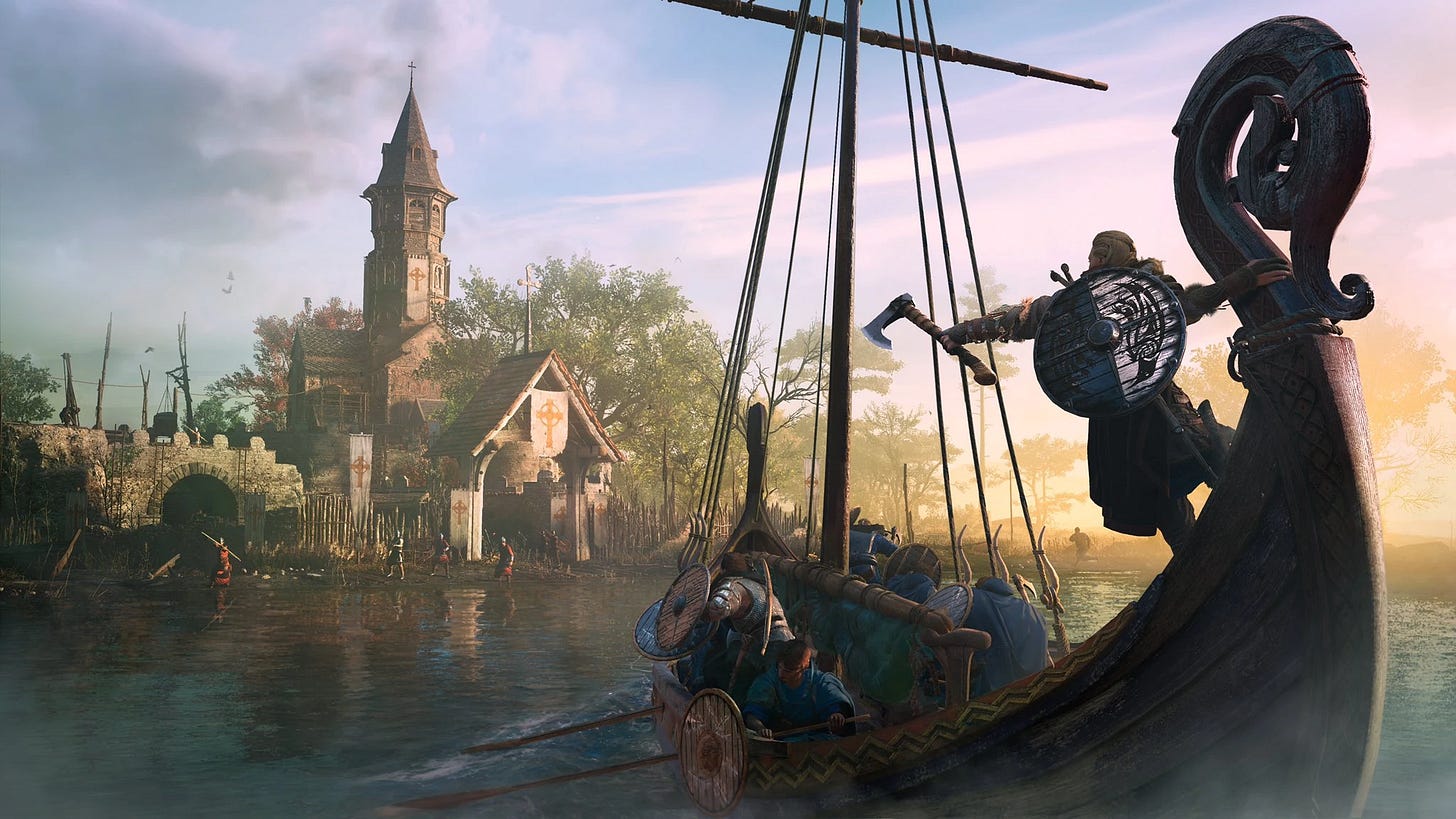
There is the task of undoing the Order’s influence throughout England, which, like Odyssey, is integrated directly into both exploration and the main story. Hunting down clues and taking on the Zealot mini-bosses, all of it tied off with the return of thematically-stylized Memory Corridors (this, running parallel to Eivor’s quest to recover knowledge thought long-forgotten from Hidden One bureaus across the country).
Throughout their adventures, as the player gathers, raids and collects resources, they’ll bring them back to Ravensthrope, the Raven Clan’s burgeoning community in England. A ramshackle war camp, slowly turned into a proper village. It is the return of the series’ homestead system which has existed in various forms since Assassin’s Creed II, though absent since III is the process of actually building a community from the ground-up.
Although it is pretty heavily on rails - the actual base building is light: all the buildings are location locked, with only resource management left to the player - this feeling is communicated well with Ravensthrope, as it is, primarily orbiting around Eivor’s commitment to her people.
Elsewhere, perhaps it is in uncovering the mystery surrounding Stonehenge (it is, surprise, surprise, an Isu site) or stumbling across an “Animus Anomaly”, a series of increasingly complex platforming challenges that, narratively, call to mind the long ago revelations of Subject Sixteen.
Or maybe it is simply acknowledging the work, the atmosphere, put forth in the game’s recreation of Dark Ages England, including the soundtrack. Co-composed by Einar Selvik alongside series veterans Jesper Kyd and Sarah Schachner, who all bring a strong, individual character to the game’s many regions.3
Though ultimately, all of these elements intersect in what it is Valhalla’s largest, most sprawling endeavour: the story.
Story (Base Game + DLC)

Much like Odyssey before it, Valhalla makes no bones of its substantial narrative ambition but instead of weaving its larger threads together, instead, it opts for a more siloed approach.
Naturally, while there is some overlap, very rarely, moment-to-moment, does it feed into the same economy.
This, perhaps best seen in the game’s main narrative crux, the pacification of England.
Almost immediately following their exodus from Norway, Eivor is tasked by Sigurd and Randvi to establish alliances with England’s various kingdoms, lords, leaders and warring factions. If their people are going to survive in this new land, they’ll need assurances and allies in equal measure. Alfred of Wessex, he has no intention of willingly conceding ground.
So while they do spiritually recall the grandeur of a classical Norse saga, in practice, these arcs, of which there are sixteen in total, more openly emulate a bottle episode of television or a comic book miniseries.
Eivor arrives in a region, quickly ingratiates herself to whoever is in charge and then goes about trying to exchange a series of favours for another. It is all feels, culturally, very in-tune. She’s drinking in meadhalls, strategizing in longhouses and burning supply lines. The inverse is often true, Eivor instead allying herself with Christian leaders who are wary to her presence but receptive to her guarantees of peace.
Either way, many conclude similarly.
Eivor leads a siege against the local ruler or opposition, uncovers treachery or deposes her target personally. Her allies are installed in power, she returns home to report on her victory to Randvi, Ravensthorpe grows and the next instalment begins.
There are some variations, of course.
One of the arcs has Eivor reuniting with a childhood friend who is unsure of his ability to lead, others see her play matchmaker not kingmaker, a couple end in object failure. A few see the reappearance of previously-introduced characters, making their mark on the overarching story in a different way.
The padding though is clear, even within the plot elements that do work. The unsure boy-king angle, for example, is very well done in East Anglia, during Valhalla’s first fifteen-twenty hours. But seeing it twice, thrice total before the credits roll with only, relatively speaking, small tweaks?
It seems only so many ideas stuck to the whiteboard. And for a game that, easily, pushes past 100-hour mark if one digs into most of what it has to offer, this is particularly uninspired.

It is a beat-by-beat, somewhat formulaic approach that, while always well presented in hewing to some semblance the real-world history it is fictionalizing, ultimately ends with a sense of incompleteness.
See, the concluding arc of Valhalla’s “conquer England” story ends with the Battle of Chippenham in January of 878. An apparent viking victory which sees Alfred go into hiding while Guthrum (Erik Madsen), Eivor and their numerous allies bask in the glow of hard-won glory.
This though, leaves out Alfred’s victory over Guthrum at Edington just a few months later, that, which lead to the signing of Treaty of Wedmore, a landmark moment in the chronicles of Saxon-Norse relations.
Now, from a purely practical, video-game perspective, this does make sense.
That feeling of completion, it wouldn’t land too well if the rug was swept out from the player all but straight away (and those threads were touched upon, briefly, in what became the game’s final expansion, The Last Chapter) but there is a momentum that seems silted regardless.
The arc regarding Eivor’s fight against the Order of the Ancients on the other hand, buoyed by a tighter feeling of progression, lands a little stronger.
On behalf of her Hidden One allies, while initially skeptical, as she assassinates various Order members from London to York, York to Winchester, from the English coast to the far reaches of present-day North America, she comes to understand just what it is they’re fighting for.
While this quest line is mostly isolated, fundamentally, it does recall the shadow war iconography of the earliest titles as the player sneaks through the streets and stamps out conspiracy, with the Vinland arc specifically, an enjoyable deep cut (as it relates to the events of Assassin’s Creed III).4
But it is the ending that is the big selling point. With the reveal that not only was Alfred manipulating events from the behind the curtain, he was the curtain.
The head of the Order, looking to dismantle them from within.
Though as Eivor tracks him down amidst his exile, he freely admits to such. His grand plan, in which Eivor was indirectly responsible for putting in motion, is to establish a God-fearing organization to live well beyond them all… The Templars.
And even if the exact same reveal (one might recall) with a mysterious and well-connected benefactor played out in Odyssey, this is a mostly well-executed conclusion to the Order story present over the Origins-Odyssey-Valhalla trilogy.
From one era of conspiracy, into the next.
It isn’t the true heart of Valhalla’s story, however.
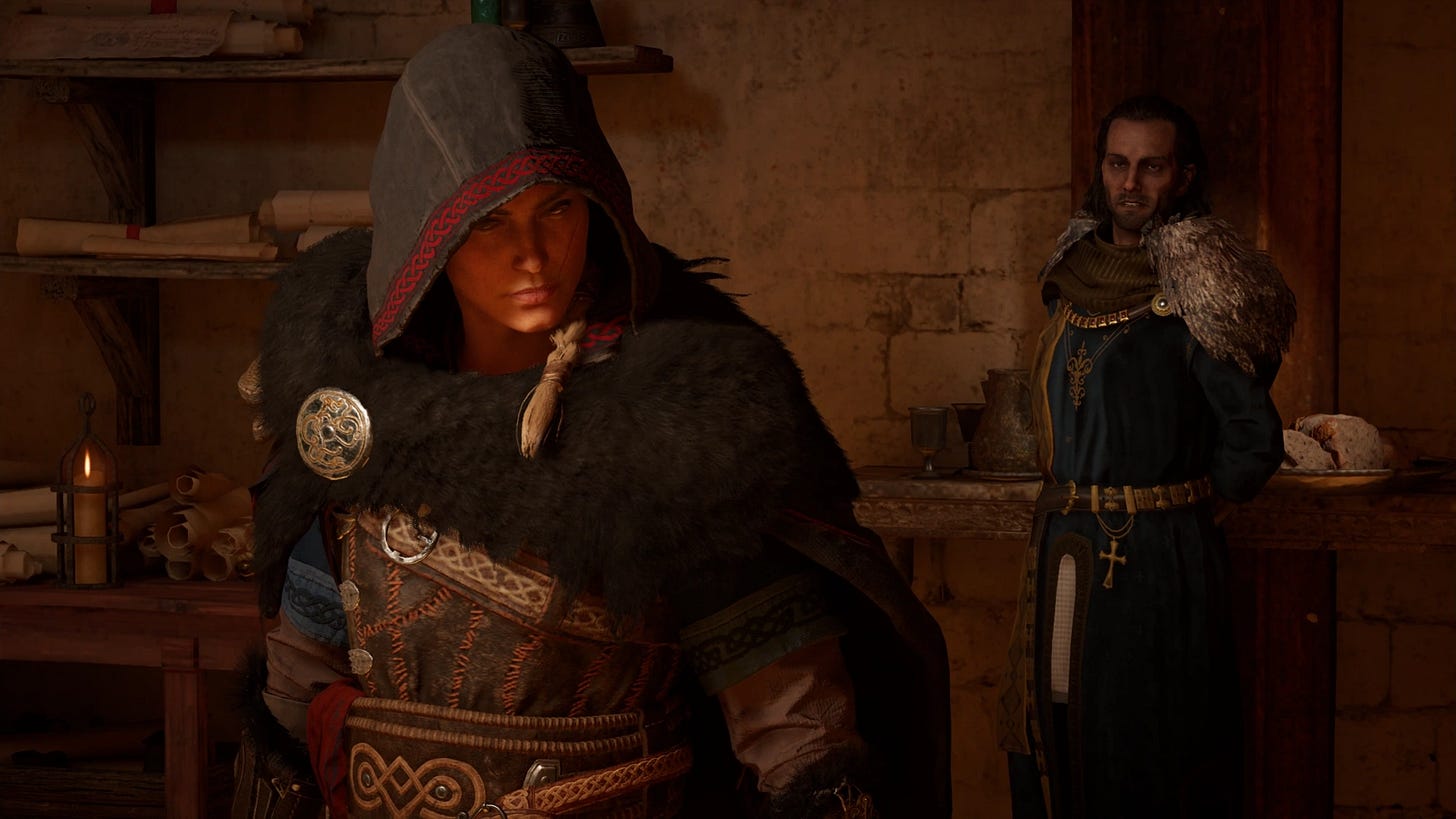
No, that lies with the narrative thread that is only really introduced around the halfway point but quickly takes centre stage. That, surrounding Eivor, Sigurd, Basim and their unlikely connection.
Continuously plagued by her visions and conversations with Odin, Eivor often struggles to deduce their meaning and in enlisting the help of clan seeress Valka (Svandis Dora Einarsdottir), hopes to find some measure of clarity. This, the lead-in behind the extended quest chains which see Eivor embody Odin himself in the mythical realms of Asgard and Jotunheim as he obsessively searches for a way to avoid his prophesied death come Ragnarök - as around him, fellow members of the Norse pantheon, Týr and Loki, scheme to their own ends.
Meanwhile, in England, subtly prompted by Basim and later tortured by Order member Fulke (Gaia Weiss), Sigurd seemingly devolves into madness, searching for ancient treasures and an apparent greater purpose.
Concurrently, as the player works their way through the Animus Anomalies, it becomes clear that there is a bigger force at play.
It all comes to a head when the adopted siblings return to Norway: Sigurd, leading Eivor to what he believes to be the gateway to the hall of heroes, Valhalla, with Basim in pursuit.
And while they find Yggdrasil, it is not the “world tree” as their legends would suggest but rather, an advanced high-tech supercomputer connected to the digital void known only as “The Grey”: for Sigurd’s supposed mania, Eivor’s visions and Basim’s duplicity, they are not delusions but instead, the resurfacing of memories.
For Eivor, Sigurd and Basim thrice are the reincarnations (Sages, in AC parlance) of Odin, Týr and Loki respectively. In series lore, not just Norse gods but the First Civilization/The Isu, the long-ago super-species that created humanity, the Pieces of Eden, their legacy.
And when Basim turns on the siblings, in revenge for the injustices he suffered as Loki at Odin’s hands eons prior, they trap him in The Grey, a prison frozen in time for which he will remain for centuries… until his voice begins to carry across the digital ocean.
As in the modern day, Layla (Chantel Riley), joined by Shaun (Danny Wallace) and Rebecca (Eliza Schneider) find themselves faced with another pending, planet-wide apocalypse which only the Assassins can stop. Though discreetly guided by Basim, by way of Eivor’s memories, while they are successful in preventing the global calamity, Basim soon leads Layla right to him.
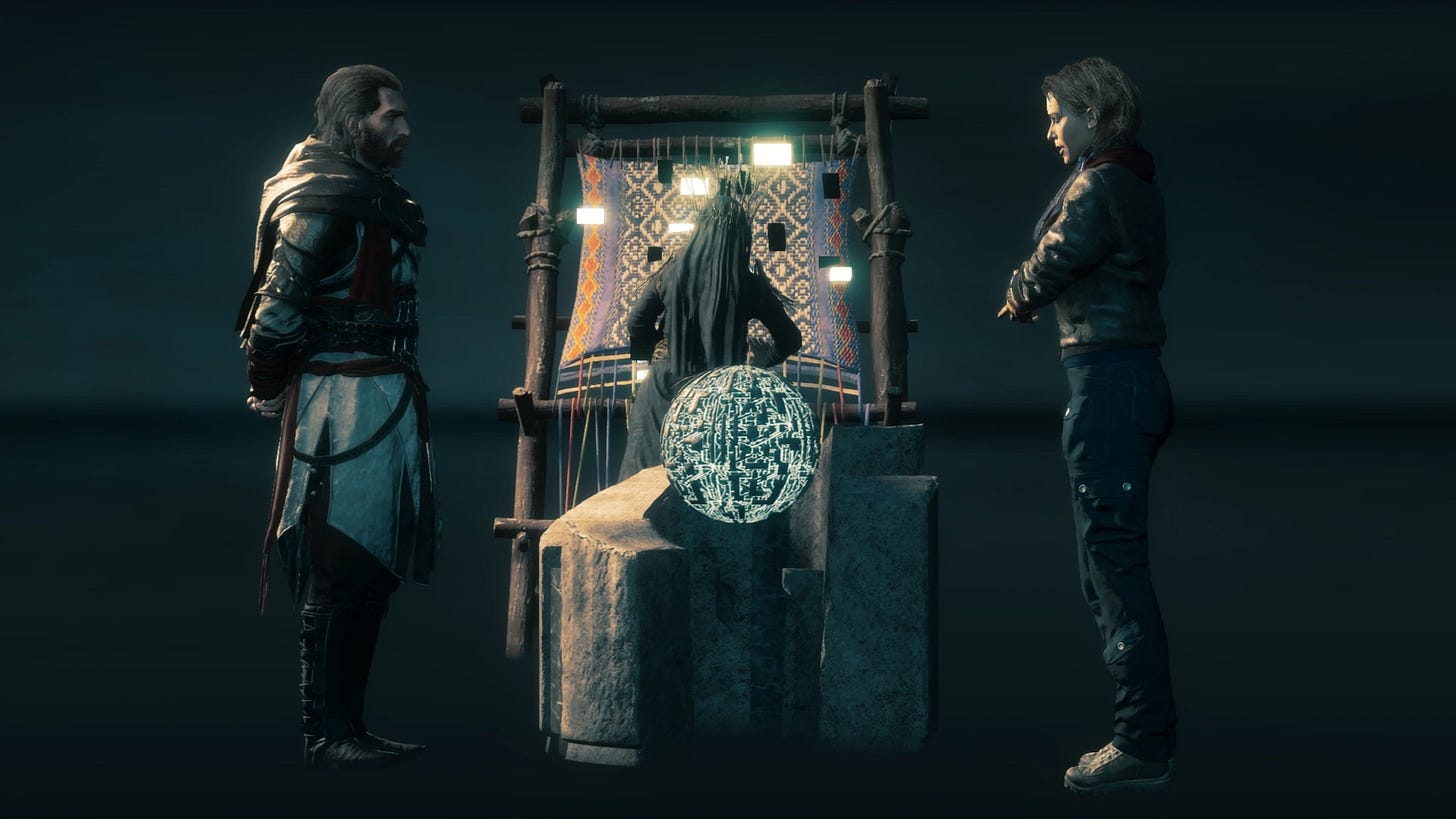
Where, with deception in hand, he frees himself from Yggdrasil, traps Layla in his place and steps into a new world.
Eager to assist the rechristened Hidden Ones but also keeping his personal motives - as is Loki’s style - close to the vest.5
Though within The Grey, Layla encounters a being who identifies himself only as The Reader.
His task is to study alternate timelines, possible futures, as to protect humanity from another potential disaster. Offering Layla a place at his side, she accepts and they commit themselves to working forever in the shadows.
Of course, AC veterans will immediately recognize The Reader as Desmond Miles (Nolan North), who survived his apparent death in Assassin’s Creed III only, it seems, to live on in a far different way.
As it stands, it is what Valhalla was clearly building towards for the entirety of its base game runtime.
Strong character work, Sages, a solid ending to Layla’s arc (given how underwhelming most her story was, though through no fault of Riley’s). Basim’s turn as a surprise modern day protagonist, Desmond’s reappearance. That feeling of “no way!” for the longtime series player as all those pieces fall into place over the final three-four hours, in embracing the (admittedly) weirder aspects of the series that have occasionally fallen by the wayside, in favour of more straightforward historical epics.
The reality of the game’s storytelling ambition however, regardless, means it is a test of personal endurance no other title in the franchise can match, the raw commitment required to simply see it through, pronounced.
The more immediate pillars, too often feeling as though they are drifting for hours, often for dozens at a time, before circling back.
More focused, in that respect, are the game’s three paid-for expansions, Wrath of the Druids, Siege of Paris and Dawn of Ragnarök.

Inherently smaller in scope, while they are very much “more of the same” in terms of what Valhalla, as a whole, has already long mastered - well-acted, solid narratively and visually impressive - each does bring something new to the table, if not radically changing the established loop.
The Forgotten Saga does a little more, with its rogue-like structure (as mentioned) and A Fated Encounter sees Eivor hunting down an Apple of Eden alongside Odyssey’s Kassandra (Melissanthi Mahut) on the Isle of Skye, to great success, both in the contrasting character dynamics and the appreciated straightforwardness in their story.
Valhalla’s full, proper conclusion though came with 2022’s The Last Chapter expansion. Eivor, believing she has done everything possible for her people, leaves Ravensthorpe behind, accepts the duality of Odin’s presence within her and sets out on a new adventure.
Though as it relates to its performances, on the supporting side, Valhalla has strength in spades.
Performances (Supporting)
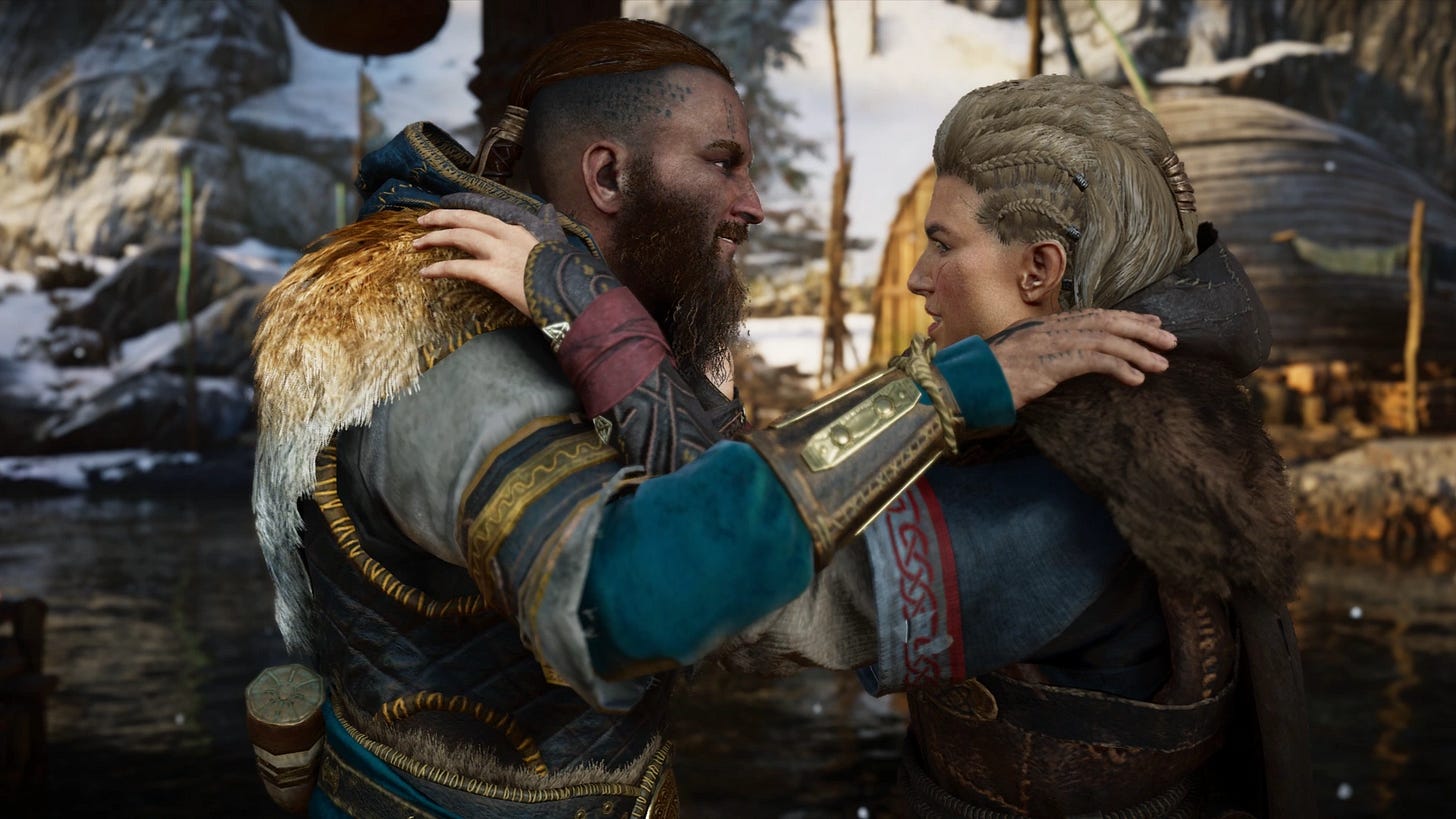
While the basis of Valhalla’s structure means each arc, each region, has its own set of stories and characters, there are quite a few standouts regardless (with many actors, fittingly, having British, Norse, Danish and broader Scandinavian heritage/backgrounds).
As Sigurd, Gudmundur Thorvaldsson is a strong presence throughout.
An accomplished warrior who has spent a lifetime being prepared for trials of leadership, it is a burden he actively takes on. Forthright, charismatic and perhaps just a little arrogant, one can believe him as a man who others would willingly follow into battle.
Speaking to this, his relationship with Eivor is key.
Having been raised alongside her, he considers her not just his right-hand but closet confidante. But as their relationship shifts come the story’s midpoint, with Sigurd becoming fully aware of his true nature, Thorvaldsson finds an effective middle ground. Coarse and uncompromising but never dishonest either, he clearly relishes in their contrast, as depending on player choices at key intervals during the story, Sigurd’s story can end one of two ways (and within the mythological arcs, he plays up a much different energy in his portrayal of Týr).
Carlo Rota as Basim (and Loki), conversely, is tasked with a hitting a variety of notes, right from the jump.
From the moment Eivor meets him, she can’t help but oscillate between total trust and justifiable unease. He is a man, seemingly, who is utterly committed to his Creed but whose darker intentions only slowly bubble to the surface as the story progresses.
Always in control, cunning, more than happy to take up something of a mentor role to Eivor, even as he steadily pokes and prods towards his ultimate goal.
Revenge, for evils from another life, long forgotten by all but him.
An performer of measured ability Rota proves himself to be then, depicting Basim’s multi-faceted transformation in the game’s final third (from supporting player, twist antagonist to modern day protagonist) all without losing his feel for the character. Basim, more than willing to admit to the follies brought on by his hubris (as The Last Chapter expansion would briefly show) with Rota finding and dictating a strong pace.
In a dual-role as warrior women Randvi and Soma, Kajsa Mohammar finds a noticeable individualism within each. Soma, a committed jarlskona devoted to her people, Randvi, Ravensthorpe’s war straightest who is instrumental in building their community (and whose relationship with Eivor, additionally, one way or another, can directly affect one sliver of the game’s ending).
There is Eric Johnson as Ivar the Boneless, who establishes himself amongst Valhalla’s many historical characters.
He wants Eivor’s respect but only, it becomes clear, to absolve himself of consequence as his sadism and single-mindedness (he will be a warrior remembered in Odin’s hall) become all-consuming. Johnson, memorable, in relatively brief work. Tom Lewis is a front-facing opportunist as Alfred, furious over the viking disruption of his big picture plans but he eventually comes to see in Eivor something of an unlikely equal, even if their goals never totally align.
To the same tune, there is Gaia Weiss as the Order member Fulke.
Apparently mad beyond reason, she initially plays both sides, presenting herself as an ally to Sigurd to gain his trust yet having already deduced what he really is, a “God”, reborn. And despite Eivor’s rage, she makes no excuses, torturing Sigurd into awakening, to the eventual cost of her life. Weiss, finding a good rhythm for a character who is, on one hand, utterly irredeemable but yet, fun to watch.
Elsewhere, while Valhalla is chock full of strong performers, they simply aren’t given too much screen-time, a byproduct of the game’s sheer scope.
Among the DLC episodes, Wrath of the Druids sees Julie Fowlis do well as Ciara, the High King’s poetess who, while against the druid fanaticism sweeping Ireland, will do anything to ensure her people survive amidst growing Christian influence, while in the Siege of Paris, as Sigfred, Sean Depner is a leader caught in crisis, his judgment, becoming continually clouded with grief.
And in concluding one of the Hidden Ones’ sub-storylines, Origins’ lead Abubakar Salim briefly reprises his role as Bayek in a voice-only cameo, bringing his signature gravitas in just a few lines of dialogue.
While as Kassandra in A Fated Encounter, a returning Melissanthi Mahut is terrific once more.

The second half of the crossover event between Odyssey and Valhalla which released in late 2021, it picks up with Kassandra’s story centuries following her departure from Greece.
Fully committed (perhaps too much so) in her goal of safeguarding mankind, after crossing paths with Eivor in Scotland, the two begrudgingly agree to work together to save the suffering populace on the Isle of Skye from a rouge Apple of Eden. Their back-and-forth dynamic, played to some humorous effect, Eivor’s blunt, to-the-point nature up against Kassandra’s more easy-going approach.
But the writers and Mahut both aren’t afraid to shy away from who Kassandra has become either. A touch sullen and somewhat socially awkward, having not lost her humanity in the face of her immortality but forced then, to carry lifetimes of survivor’s guilt for all the loved ones she couldn’t save.
It is a development to her characterization that Mahut brings to wonderful life as, with Eivor’s help, Kassandra rediscovers the reason why she is fighting in the first place, working to bridge a gap in the character’s long-running story.
Though taking the largest spotlight are Valhalla’s lead performances, the game’s bulwark, from the shores of Norway and back again.
Performances (Leads)
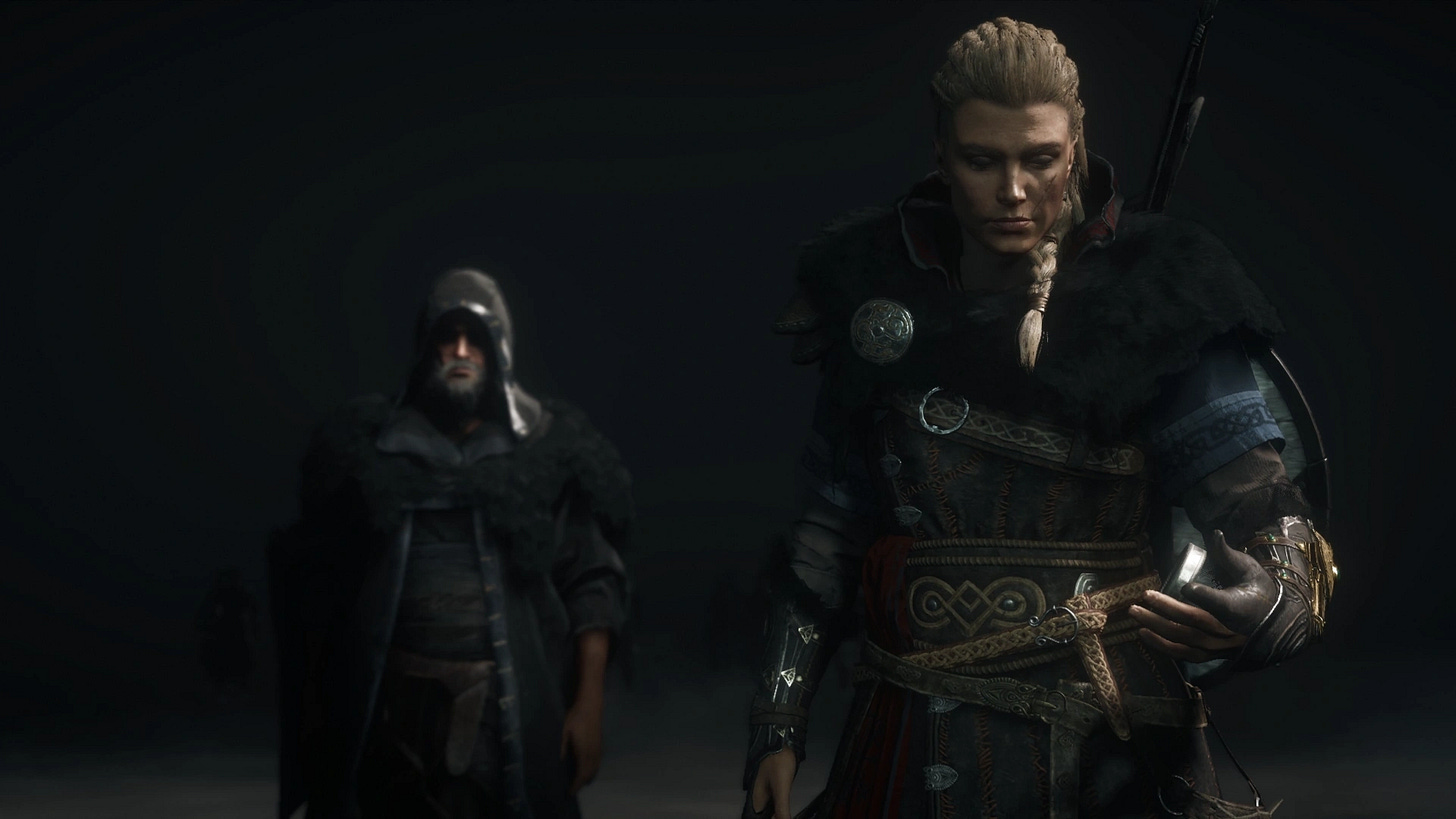
As Odyssey did, Valhalla gives the player the option to choose their protagonist but while Kassandra and Alexios (Michael Antonakos) were both fully-realized, individual characters, Valhalla plays out differently.
Eivor can be either male (Magnus Bruun) or female (Cecilie Stenspil), with Brunn, regardless, also portraying Odin (and with both, additionally, also playing the roles of Eivor’s parents)
What is notable however, is how each interpreted the character in their own way: pulling on a different aspect of Eivor’s larger characterization, be it within the physicality of their performance capture or even the minute of their work in the booth, as both spoke to in the game’s promotional material.
And while it was later clarified that the canon choice was game’s default option which sees Stenspil in the lead, save for the mythological arcs (where Bruun takes that stage) both make their imprint on the game through their committed, lived-in performances.
As Odin, Bruun is a man who steadily bides his time.
Upon first appearing to Eivor, it is to offer wisdom, guidance. He sees her potential, as a warrior and leader, as a woman who will be remembered and he hopes to assist her however he can. Brunn leans into this, his delivery throughout much of the first and second acts, calm and collected.
Notions of glory and the hard cost it requires.
As the personification, to Eivor’s initial rationalization, of the Norse god himself, he speaks to her cultural understanding and personal aspirations but as the game goes on, it becomes clear his mentorship is not wholly altruistic: actively pushing Eivor, to her growing unease, to pursue power and abject cruelty against her allies and enemies alike, her own gain, the only thing that truly matters.
Brunn finds a really strong grove here, especially as Valhalla’s base campaign enters its final stretch. Odin, becoming increasingly forceful, paranoid and dismissive, refusing to grant Eivor any sort of leeway in her reasoning, more so during their climatic confrontation, deep in the recesses of Eivor’s mind.
He respects her enough to stand on her own not unlike Sigurd and Basim who were forced to fully grapple with the horrors of their past lives but he will not be ignored either, Brunn, hitting a particularly imposing fury as Eivor chooses (at first) to cast him out.
It is a far different side to the Odin though who is shown within all of Valhalla’s mythological segments.
Wise and personable, eager to learn, to truly teach, if not without those lesser qualities, as well.
He is determined to face the looming threat of Ragnarök head on by whatever means necessary be it through deception or sacrifice, any measure of treachery, as decried by Loki or Týr, it is for an unrealized “greater good”, for as far as it can carry him. Though conversely, almost paradoxically, he holds his title of All-Father in the highest regard.
Wanting to assist those, even in the midst of crises, who would appeal to his consul.
Brunn makes these differing facets land with a notable, impressive consistency as, in essence, he is playing the same character only in two very different ways, depending on the moment.
But within both, his delivery doesn’t once waver.
As Eivor, Stenspil takes a character who is seemingly one thing, a deeply hardened, unmoving exterior and works to slowly (but surely) peel those layers away.
Deeply traumatized by the callous loss of her parents as a child, she keeps her emotions under close guard, as is cultural custom.
She is resolute in her desire for justice but equally as steadfast in her commitment to a specific view of honour. In laying down his axe in favour of surrender, she is disgusted by what she holds to be her father’s unforgivable cowardice and swears she will rise about it.
More than just a warrior who strived for the glory, she will be sung about in the meadhalls and longhouses for generations to come. So when England comes knocking?
Well, it is the opportunity she has been waiting for.
But Stenspil’s portrayal, next to the work of the lager writing team, is incredibly diligent. For as she crafts that legend, from the moors to every border of the Isle, Eivor comes to realize that honour, as she understood it, is not as simplistic nor black-and-white but instead, wholly human. Her encounters with Ivar, the Hidden Ones and even Alfred, showing steadily changing personal tides.
She seemingly prefers just one language, violence, be it through her presence alone or acted on physical threats. A formidable drengr for whom the roar of conflict is as common as breathing, she cannot be played easily. Her reputation on the battlefield, it quickly becomes clear to those who doubt her, one that is rightfully earned.
Though when she allows herself to relax, just ever-so slightly, so many other dimensions come into focus: a keen person-to-person and war strategist, who is not too proud to admit to her mistakes.
A poet of sorts, who often speaks in verse, one who, when in the company of those she trusts, is prone to a biting wit and even harder-hitting sarcasm.
She has a soft spot for wayward children, of which she was once one and a weaker inclination for mead. An at-first somewhat cynical view of a Hidden Ones that, in time, matures into a deep mutual respect. Unlike many of her viking contemporaries, she doesn’t hold any particular prejudice against Christians. Quick to call out any vocalized hypocrisy yes but also willing to learn and understand whatever she can, both for her own benefit and that of her people. That, a burning love for those of Ravensthorpe that supersedes any one allegiance as she eventually becomes, in full, their jarlskona.
Power then, even in its most selfless form, something of a continued worry, given her complex relationship with Odin.
It is a dynamic that evolves gradually over the course of Valhalla’s base story, Eivor coming to reject not just Odin’s influence but his presence altogether. Her experience in Yggdrasil, causing her to see that the glory in death she has fought so hard for, is hollow and lacking purpose.
Empty, in all the worse ways.
To simply be grateful for each and every day, it must and shall be, enough. In a rare moment of shared vulnerability she admits as much to Guthrum, following their victory in Chippenham. The cost of war, it is no longer something she wishes to pursue with such caviller, juvenile abandon.
To keep her loved ones safe, it is the only goal worth raising an axe towards.
Stenspil, giving each of these elements a lived-in quality that, within their breadth alone, is remarkably impressive: something further crystallized in The Siege of Paris. Historically and chronologically, the expansion takes place some seven years following the end of the base game’s story and Eivor, it is clear, is weary now, of killing only for the sake of conquest or vengeance.
Charles the Fat (JB Blanc) may have the people of Paris in a vice grip but as Eivor repeatedly tries, to the disagreement of her allies and foes both, to reach a truce without the spilling of unnecessary blood, it is in realizing she has completely moved beyond the desire the others crave so deeply. The later reliving of Odin’s experiences in Svartalfheim (during the events of Dawn of Ragnarök) and then, The Last Chapter, seeing her embrace that search for self-discovery.
The lifelong warrior, departing Ravensthorpe to learn from the duality that exists within her, accepting that, with everything she has learned (and everything she is), there is a way forward in life that requires honour of a different sort.
All this, for which Stenspil delivers to great effect, binding so much of Valhalla together.
Outro (Valhalla)
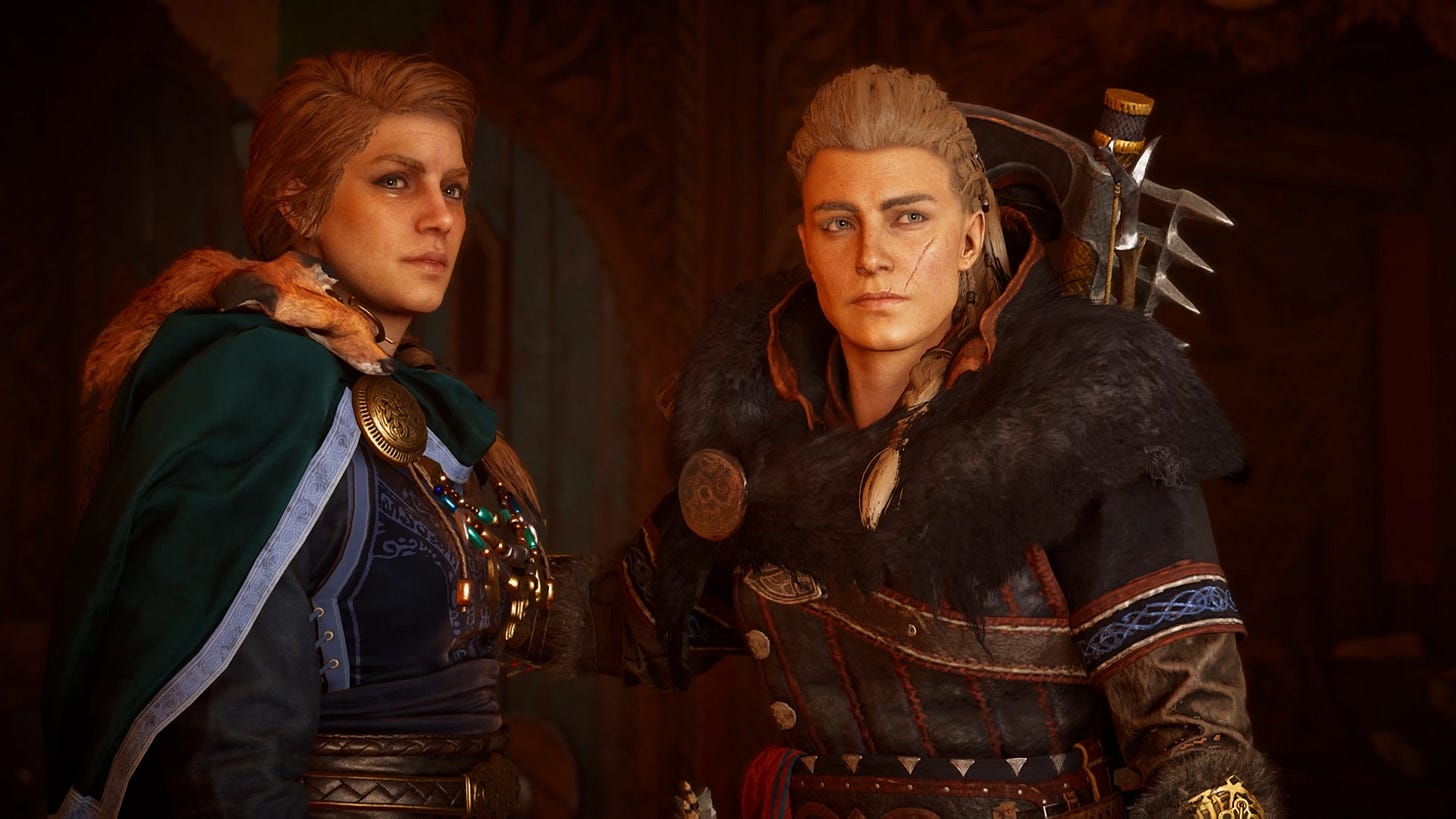
Valhalla isn’t without its fair share of flaws or ideas that simply missed the mark altogether.
Though it eventually sees its best plot-lines land with success, the total scope of its narrative is simply too unwieldy (and often disjointed) for its own good. The stealth mechanics never develop behind their introductory baseline in the base game, nor does the parkour.
Exploration requires one to master the art of dedicated time management if they want any hope of making it through to the end without too many hours going unscathed, amidst mechanics and side material that are simply far too undercooked to justify their prevalence.
But again, for what it does excel in, the game swings for the fences.
The closing story elements are played strongly, especially for long-time series fans, visually, the open world impresses and the performances, from the vast supporting cast to the locked-in leads never slouch, noteworthy, given the sheer amount of material they were asked to bring to life.
The road to Odin’s hall may be one of great challenge in the sagas of old and while the game isn’t immune to that feeling whatsoever, it is a worthy addition to a series all the same. One which has traded its name on experiences for nearly two decades now and on that note alone, Valhalla lands with a particular conviction one can’t help but respect.
Though speaking on it, if you missed them then, do be sure, if you’re so curious, to check out my retrospectives on AC: Black Flag, Unity, Syndicate and Odyssey, in addition to my review of Shadows that ran earlier this year.
It must be said here that, yes, Valhalla’s London, within its physical presentation, veers quite far from known historical fact. In of itself, something that is out of form for the series, considering its usual fidelity to relative accuracy in that particular arena. But conversely, it is also understood that certain concessions must always be made in the pursuit of player enjoyment. And hey, when all is said and done? Scrambling through the city by way of still maintained Roman ruins, albeit, hundreds of years too late is quite fun (a worthwhile concession).
Equally so, for the DLC episodes with composer Stephanie Economou, notably, winning a Grammy for her work on Dawn of Ragnarök.
After defeating the Ancient Gorm and recovering his Piece of Eden - a very particular Crystal Ball - Eivor entrusts it to the Kanien’kehá:ka peoples that she has allied with before returning home. Centuries later, at the dawn of the American Revolution, a young Ratonhnhaké:ton/Connor (Noah Watts) will use it to speak with Juno (Nadia Verrucci), who directs him to the Davenport Homestead: thus beginning his involvement proper in the Assassin-Templar conflict.
While broadly hinted at during the mythological arcs, completing all the Animus Anomalies throughout the world does provide further context to Basim’s motives, specifically regarding his/Loki’s relationship with Aletheia. Both wanting to live beyond Ragnarök - if repackaged here with a Norse sheen, itself still the long-running piece of series lore known as the First Civilization destroying “Great Catastrophe” - they scheme to ensure their immortality in far different ways with both, eventually, succeeding. Believing that he can find answers regarding the fate of Loki’s family post Ragnarök however, upon his emergence in the 2020s, Basim enters the Animus in an effort to explore Eivor and Odin’s memories. Meanwhile, his past, specifically his journey of self-discovery regarding his true nature was further shown in Valhalla’s succeeding title, 2023’s prequel, Mirage.




